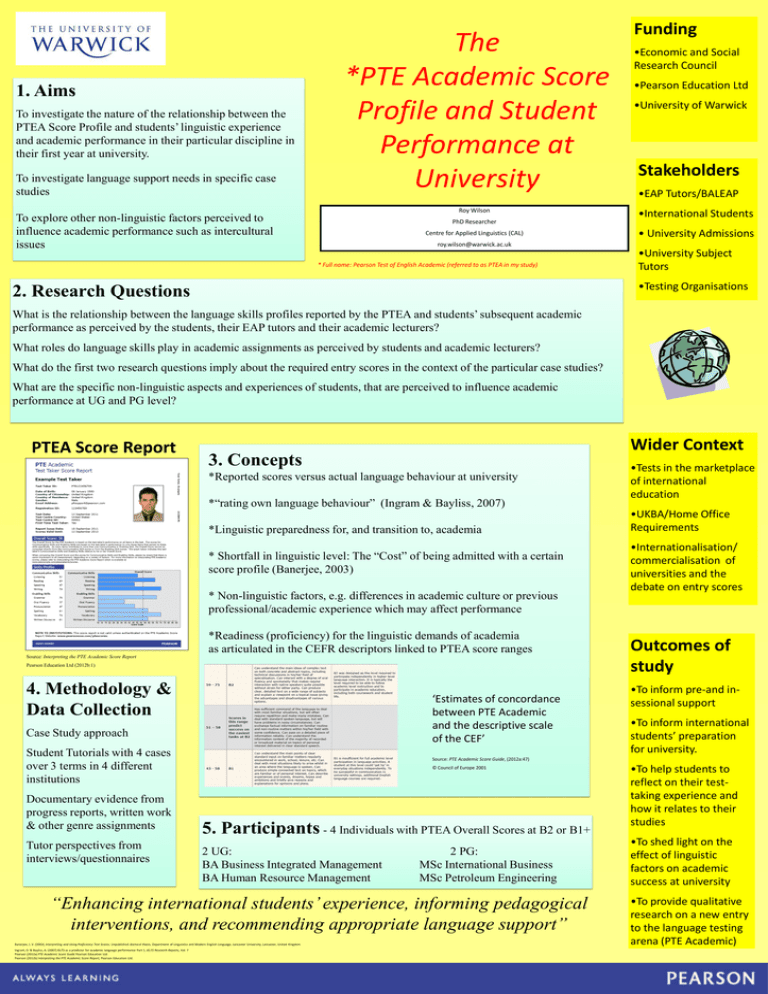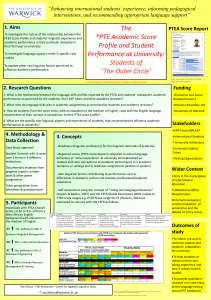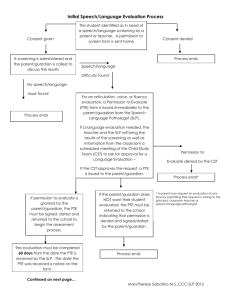The *PTE Academic Score Profile and Student
advertisement

1. Aims To investigate the nature of the relationship between the PTEA Score Profile and students’ linguistic experience and academic performance in their particular discipline in their first year at university. To investigate language support needs in specific case studies The *PTE Academic Score Profile and Student Performance at University Roy Wilson To explore other non-linguistic factors perceived to influence academic performance such as intercultural issues PhD Researcher Centre for Applied Linguistics (CAL) Funding •Economic and Social Research Council •Pearson Education Ltd •University of Warwick Stakeholders •EAP Tutors/BALEAP •International Students • University Admissions roy.wilson@warwick.ac.uk * Full name: Pearson Test of English Academic (referred to as PTEA in my study) •University Subject Tutors •Testing Organisations 2. Research Questions What is the relationship between the language skills profiles reported by the PTEA and students’ subsequent academic performance as perceived by the students, their EAP tutors and their academic lecturers? What roles do language skills play in academic assignments as perceived by students and academic lecturers? What do the first two research questions imply about the required entry scores in the context of the particular case studies? What are the specific non-linguistic aspects and experiences of students, that are perceived to influence academic performance at UG and PG level? PTEA Score Report Wider Context 3. Concepts *Reported scores versus actual language behaviour at university *“rating own language behaviour” (Ingram & Bayliss, 2007) *Linguistic preparedness for, and transition to, academia * Shortfall in linguistic level: The “Cost” of being admitted with a certain score profile (Banerjee, 2003) * Non-linguistic factors, e.g. differences in academic culture or previous professional/academic experience which may affect performance *Readiness (proficiency) for the linguistic demands of academia as articulated in the CEFR descriptors linked to PTEA score ranges Source: Interpreting the PTE Academic Score Report Pearson Education Ltd (2012b:1) 4. Methodology & Data Collection ‘Estimates of concordance between PTE Academic and the descriptive scale of the CEF’ Case Study approach Student Tutorials with 4 cases over 3 terms in 4 different institutions Documentary evidence from progress reports, written work & other genre assignments Tutor perspectives from interviews/questionnaires •UKBA/Home Office Requirements •Internationalisation/ commercialisation of universities and the debate on entry scores Outcomes of study •To inform pre-and insessional support •To inform international students’ preparation for university. Source: PTE Academic Score Guide, (2012a:47) © Council of Europe 2001 5. Participants - 4 Individuals with PTEA Overall Scores at B2 or B1+ 2 UG: BA Business Integrated Management BA Human Resource Management 2 PG: MSc International Business MSc Petroleum Engineering “Enhancing international students’ experience, informing pedagogical interventions, and recommending appropriate language support” Banerjee, J. V. (2003), Interpreting and Using Proficiency Test Scores. Unpublished doctoral thesis, Department of Linguistics and Modern English Language, Lancaster University, Lancaster, United Kingdom Ingram, D. & Bayliss, A. (2007) IELTS as a predictor for academic language performance Part 1, IELTS Research Reports, Vol. 7 Pearson (2012a) PTE Academic Score Guide Pearson Education Ltd. Pearson (2012b) Interpreting the PTE Academic Score Report, Pearson Education Ltd. •Tests in the marketplace of international education •To help students to reflect on their testtaking experience and how it relates to their studies •To shed light on the effect of linguistic factors on academic success at university •To provide qualitative research on a new entry to the language testing arena (PTE Academic)


